check engine AUDI A6 1999 C5 / 2.G ATW Engine Electronic Power Control Checking Workshop Manual
[x] Cancel search | Manufacturer: AUDI, Model Year: 1999, Model line: A6, Model: AUDI A6 1999 C5 / 2.GPages: 51, PDF Size: 0.3 MB
Page 1 of 51
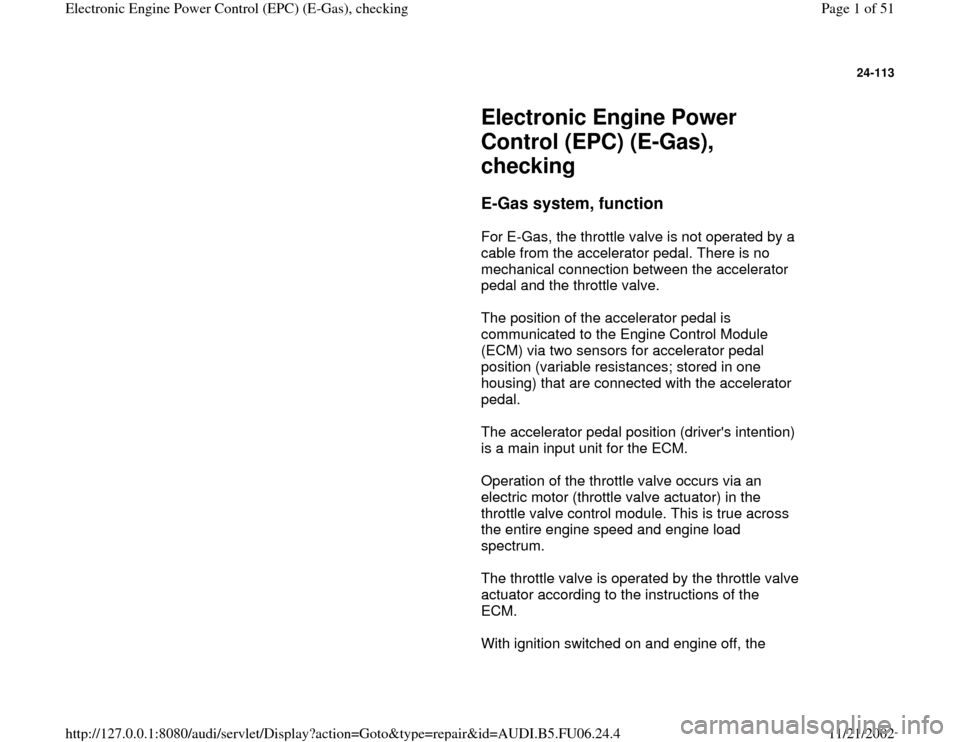
24-113
Electronic Engine Power
Control (EPC) (E-Gas),
checking
E-Gas system, function
For E-Gas, the throttle valve is not operated by a
cable from the accelerator pedal. There is no
mechanical connection between the accelerator
pedal and the throttle valve.
The position of the accelerator pedal is
communicated to the Engine Control Module
(ECM) via two sensors for accelerator pedal
position (variable resistances; stored in one
housing) that are connected with the accelerator
pedal.
The accelerator pedal position (driver's intention)
is a main input unit for the ECM.
Operation of the throttle valve occurs via an
electric motor (throttle valve actuator) in the
throttle valve control module. This is true across
the entire engine speed and engine load
spectrum.
The throttle valve is operated by the throttle valve
actuator according to the instructions of the
ECM.
With ignition switched on and engine off, the
Pa
ge 1 of 51 Electronic En
gine Power Control
(EPC
) (E-Gas
), checkin
g
11/21/2002 htt
p://127.0.0.1:8080/audi/servlet/Dis
play?action=Goto&t
yp
e=re
pair&id=AUDI.B5.FU06.24.4
Page 3 of 51
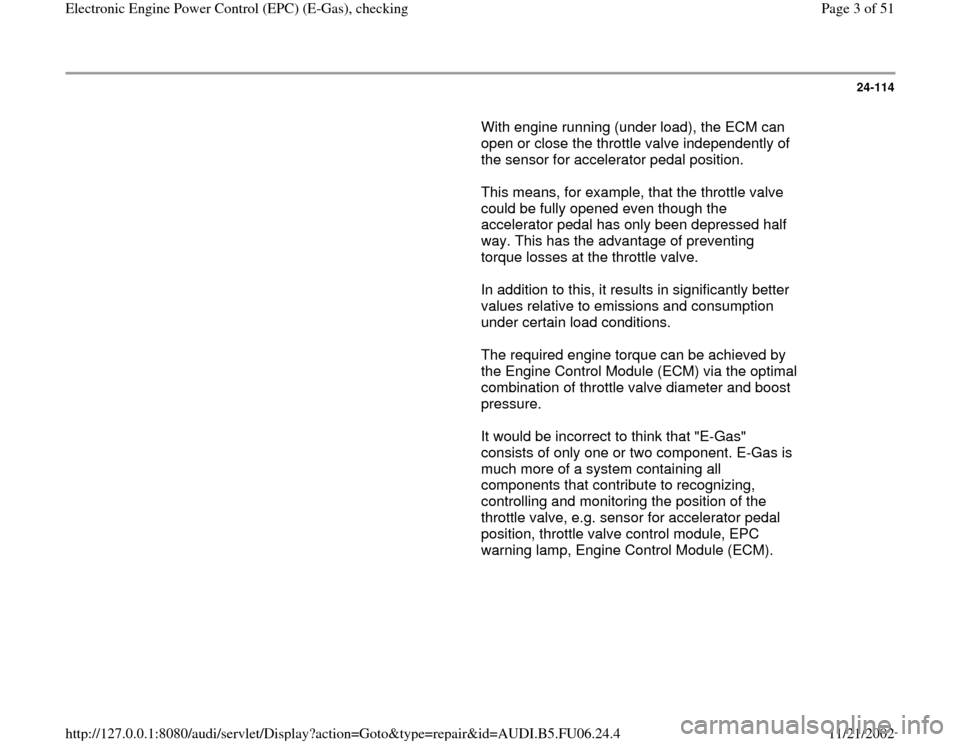
24-114
With engine running (under load), the ECM can
open or close the throttle valve independently of
the sensor for accelerator pedal position.
This means, for example, that the throttle valve
could be fully opened even though the
accelerator pedal has only been depressed half
way. This has the advantage of preventing
torque losses at the throttle valve.
In addition to this, it results in significantly better
values relative to emissions and consumption
under certain load conditions.
The required engine torque can be achieved by
the Engine Control Module (ECM) via the optimal
combination of throttle valve diameter and boost
pressure.
It would be incorrect to think that "E-Gas"
consists of only one or two component. E-Gas is
much more of a system containing all
components that contribute to recognizing,
controlling and monitoring the position of the
throttle valve, e.g. sensor for accelerator pedal
position, throttle valve control module, EPC
warning lamp, Engine Control Module (ECM).
Pa
ge 3 of 51 Electronic En
gine Power Control
(EPC
) (E-Gas
), checkin
g
11/21/2002 htt
p://127.0.0.1:8080/audi/servlet/Dis
play?action=Goto&t
yp
e=re
pair&id=AUDI.B5.FU06.24.4
Page 4 of 51
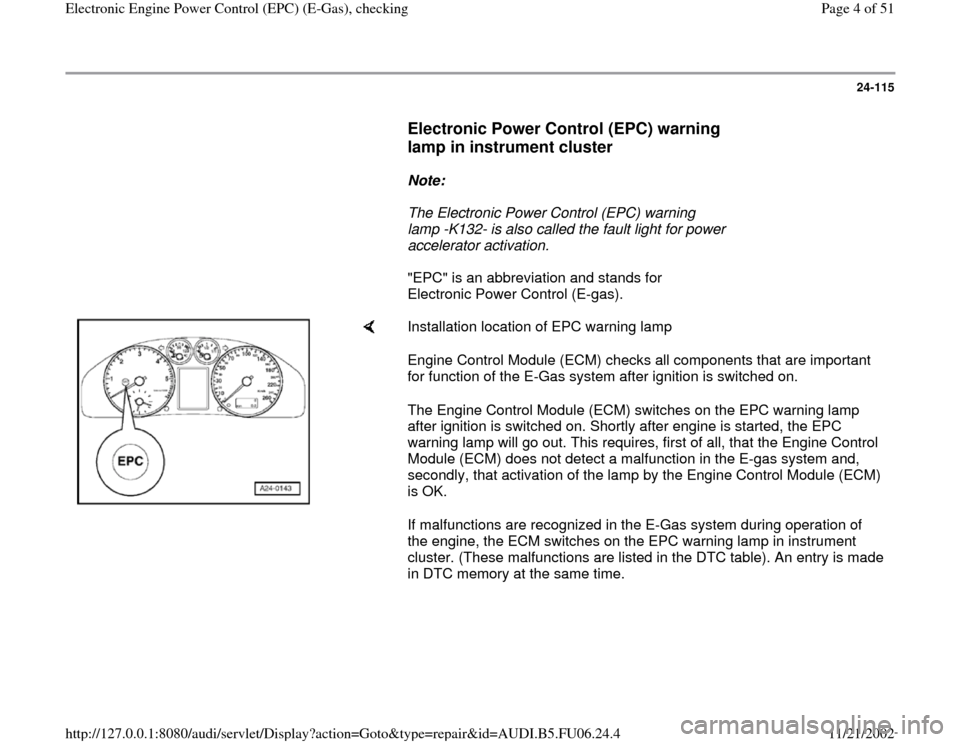
24-115
Electronic Power Control (EPC) warning
lamp in instrument cluster
Note:
The Electronic Power Control (EPC) warning
lamp -K132- is also called the fault light for power
accelerator activation.
"EPC" is an abbreviation and stands for
Electronic Power Control (E-gas).
Installation location of EPC warning lamp
Engine Control Module (ECM) checks all components that are important
for function of the E-Gas system after ignition is switched on.
The Engine Control Module (ECM) switches on the EPC warning lamp
after ignition is switched on. Shortly after engine is started, the EPC
warning lamp will go out. This requires, first of all, that the Engine Control
Module (ECM) does not detect a malfunction in the E-gas system and,
secondly, that activation of the lamp by the Engine Control Module (ECM)
is OK.
If malfunctions are recognized in the E-Gas system during operation of
the engine, the ECM switches on the EPC warning lamp in instrument
cluster. (These malfunctions are listed in the DTC table). An entry is made
in DTC memory at the same time.
Pa
ge 4 of 51 Electronic En
gine Power Control
(EPC
) (E-Gas
), checkin
g
11/21/2002 htt
p://127.0.0.1:8080/audi/servlet/Dis
play?action=Goto&t
yp
e=re
pair&id=AUDI.B5.FU06.24.4
Page 6 of 51
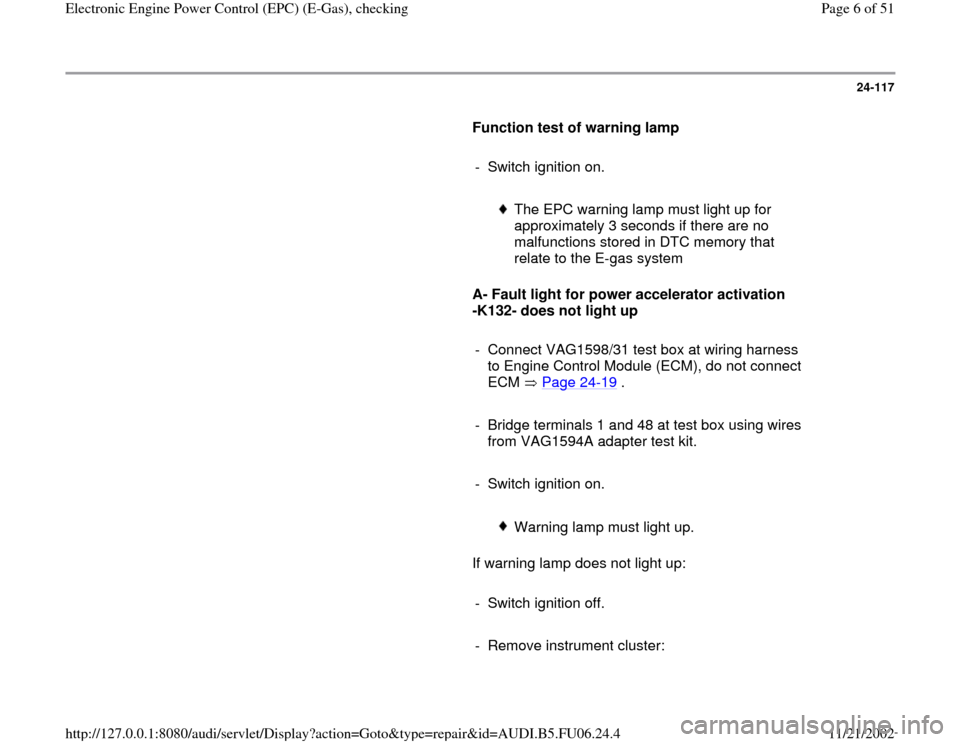
24-117
Function test of warning lamp
- Switch ignition on.
The EPC warning lamp must light up for
approximately 3 seconds if there are no
malfunctions stored in DTC memory that
relate to the E-gas system
A- Fault light for power accelerator activation
-K132- does not light up
- Connect VAG1598/31 test box at wiring harness
to Engine Control Module (ECM), do not connect
ECM Page 24
-19
.
- Bridge terminals 1 and 48 at test box using wires
from VAG1594A adapter test kit.
- Switch ignition on.
Warning lamp must light up.
If warning lamp does not light up:
- Switch ignition off.
- Remove instrument cluster:
Pa
ge 6 of 51 Electronic En
gine Power Control
(EPC
) (E-Gas
), checkin
g
11/21/2002 htt
p://127.0.0.1:8080/audi/servlet/Dis
play?action=Goto&t
yp
e=re
pair&id=AUDI.B5.FU06.24.4
Page 8 of 51
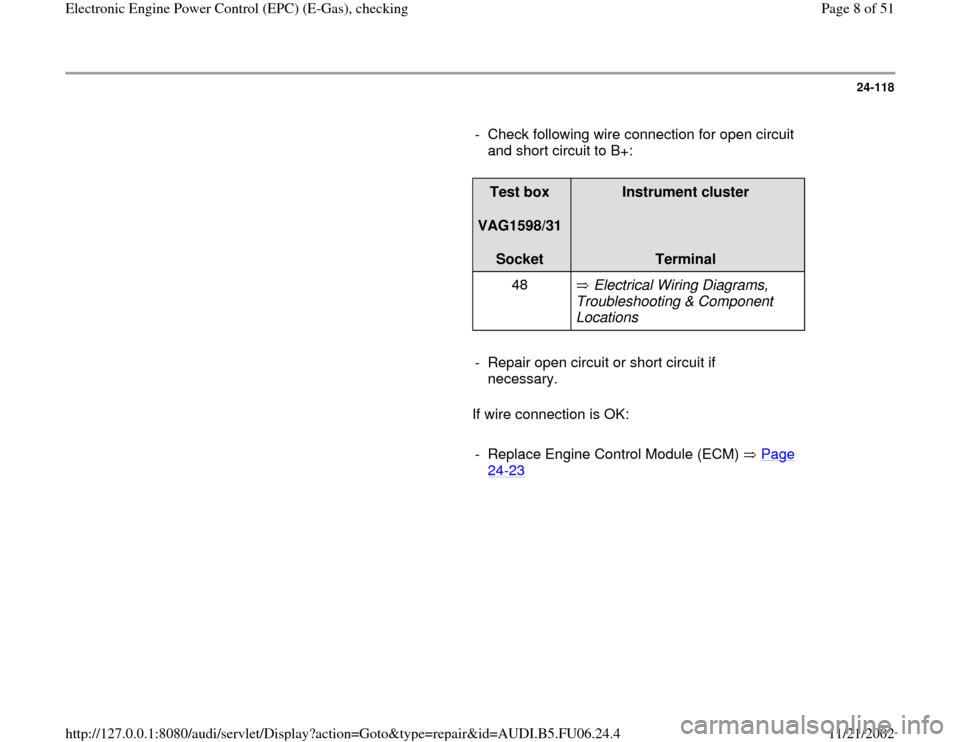
24-118
- Check following wire connection for open circuit
and short circuit to B+:
Test box
VAG1598/31
Socket
Instrument cluster
Terminal
48 Electrical Wiring Diagrams,
Troubleshooting & Component
Locations
- Repair open circuit or short circuit if
necessary.
If wire connection is OK:
- Replace Engine Control Module (ECM) Page
24
-23
Pa
ge 8 of 51 Electronic En
gine Power Control
(EPC
) (E-Gas
), checkin
g
11/21/2002 htt
p://127.0.0.1:8080/audi/servlet/Dis
play?action=Goto&t
yp
e=re
pair&id=AUDI.B5.FU06.24.4
Page 9 of 51
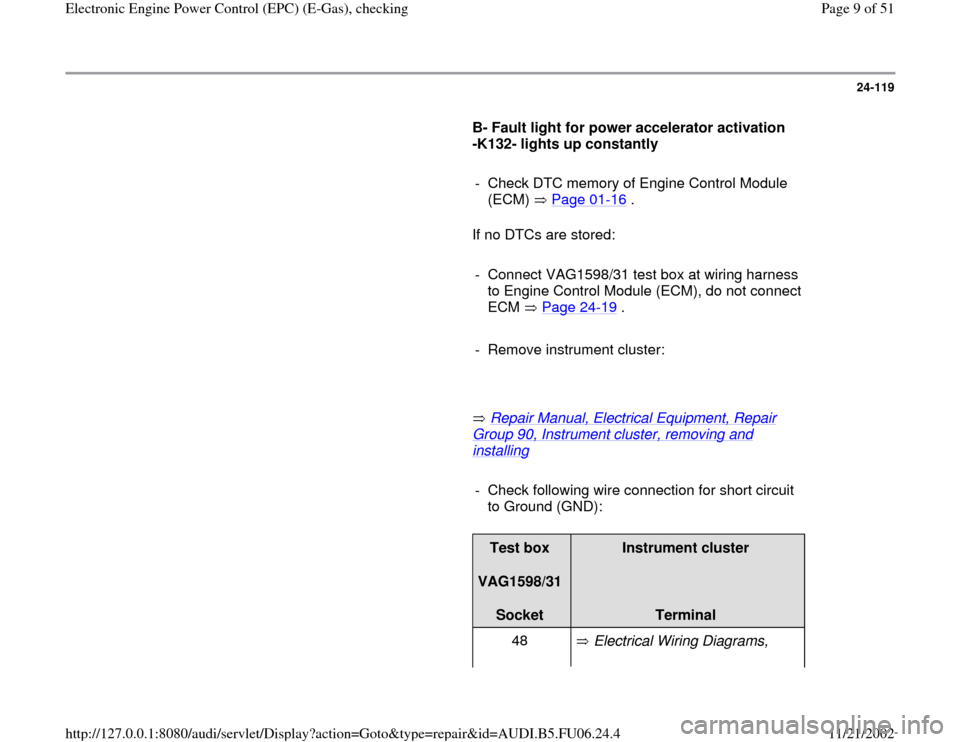
24-119
B- Fault light for power accelerator activation
-K132- lights up constantly
- Check DTC memory of Engine Control Module
(ECM) Page 01
-16
.
If no DTCs are stored:
- Connect VAG1598/31 test box at wiring harness
to Engine Control Module (ECM), do not connect
ECM Page 24
-19
.
- Remove instrument cluster:
Repair Manual, Electrical Equipment, Repair
Group 90, Instrument cluster, removing and installing
- Check following wire connection for short circuit
to Ground (GND):
Test box
VAG1598/31
Socket
Instrument cluster
Terminal
48 Electrical Wiring Diagrams,
Pa
ge 9 of 51 Electronic En
gine Power Control
(EPC
) (E-Gas
), checkin
g
11/21/2002 htt
p://127.0.0.1:8080/audi/servlet/Dis
play?action=Goto&t
yp
e=re
pair&id=AUDI.B5.FU06.24.4
Page 10 of 51
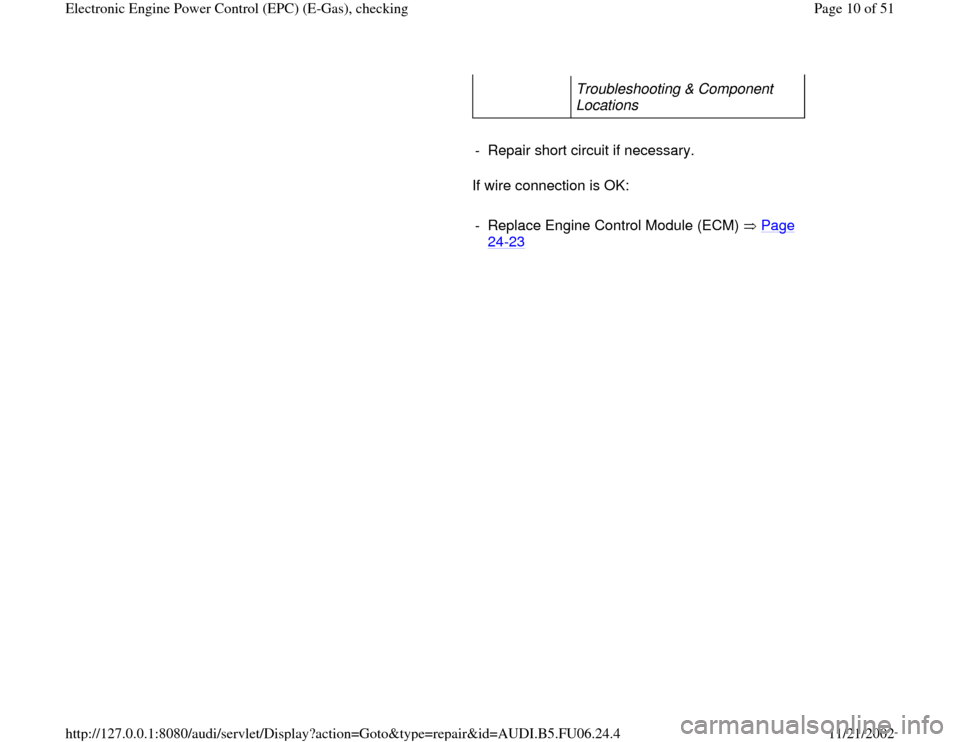
Troubleshooting & Component
Locations
- Repair short circuit if necessary.
If wire connection is OK:
- Replace Engine Control Module (ECM) Page
24
-23
Pa
ge 10 of 51 Electronic En
gine Power Control
(EPC
) (E-Gas
), checkin
g
11/21/2002 htt
p://127.0.0.1:8080/audi/servlet/Dis
play?action=Goto&t
yp
e=re
pair&id=AUDI.B5.FU06.24.4
Page 11 of 51
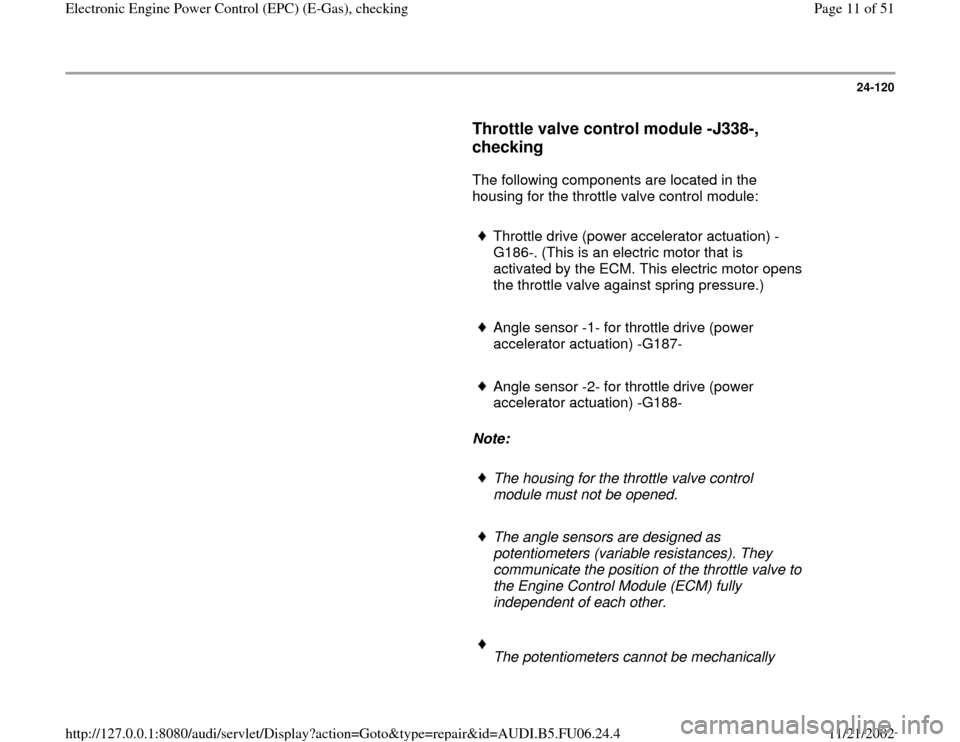
24-120
Throttle valve control module -J338-,
checking
The following components are located in the
housing for the throttle valve control module:
Throttle drive (power accelerator actuation) -
G186-. (This is an electric motor that is
activated by the ECM. This electric motor opens
the throttle valve against spring pressure.)
Angle sensor -1- for throttle drive (power
accelerator actuation) -G187-
Angle sensor -2- for throttle drive (power
accelerator actuation) -G188-
Note:
The housing for the throttle valve control
module must not be opened.
The angle sensors are designed as
potentiometers (variable resistances). They
communicate the position of the throttle valve to
the Engine Control Module (ECM) fully
independent of each other.
The potentiometers cannot be mechanically
Pa
ge 11 of 51 Electronic En
gine Power Control
(EPC
) (E-Gas
), checkin
g
11/21/2002 htt
p://127.0.0.1:8080/audi/servlet/Dis
play?action=Goto&t
yp
e=re
pair&id=AUDI.B5.FU06.24.4
Page 13 of 51
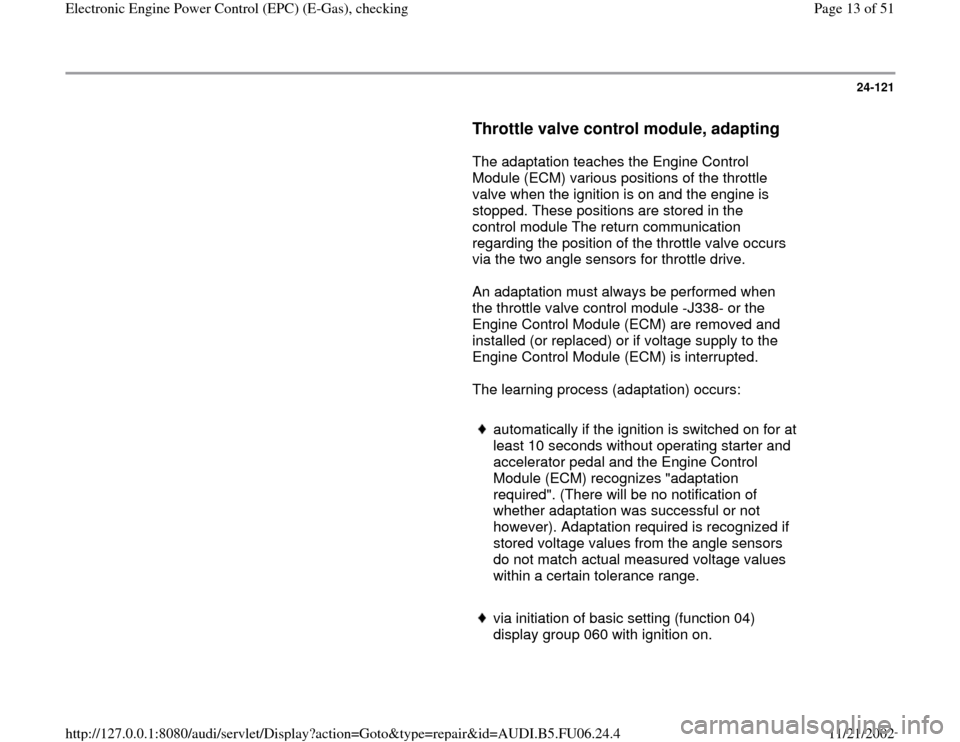
24-121
Throttle valve control module, adapting
The adaptation teaches the Engine Control
Module (ECM) various positions of the throttle
valve when the ignition is on and the engine is
stopped. These positions are stored in the
control module The return communication
regarding the position of the throttle valve occurs
via the two angle sensors for throttle drive.
An adaptation must always be performed when
the throttle valve control module -J338- or the
Engine Control Module (ECM) are removed and
installed (or replaced) or if voltage supply to the
Engine Control Module (ECM) is interrupted.
The learning process (adaptation) occurs:
automatically if the ignition is switched on for at
least 10 seconds without operating starter and
accelerator pedal and the Engine Control
Module (ECM) recognizes "adaptation
required". (There will be no notification of
whether adaptation was successful or not
however). Adaptation required is recognized if
stored voltage values from the angle sensors
do not match actual measured voltage values
within a certain tolerance range.
via initiation of basic setting (function 04)
display group 060 with ignition on.
Pa
ge 13 of 51 Electronic En
gine Power Control
(EPC
) (E-Gas
), checkin
g
11/21/2002 htt
p://127.0.0.1:8080/audi/servlet/Dis
play?action=Goto&t
yp
e=re
pair&id=AUDI.B5.FU06.24.4
Page 14 of 51

24-122
Note:
Engine will not start during automatic adaptation.
Special tools and equipment
or
Requirements
VAS5051 with VAG5051/1VAG1551 with VAG1551/3ANo DTCs in DTC memory, check DTC memory Page 01
-16
.
Engine not running, ignition switched on. Accelerator pedal not depressed. Coolant temperature 10 to 95 C. Intake air temperature 10 to 90 C. Supply voltage for Engine Control Module (ECM) more than 12.7
volts; checking Page 28
-36
.
Pa
ge 14 of 51 Electronic En
gine Power Control
(EPC
) (E-Gas
), checkin
g
11/21/2002 htt
p://127.0.0.1:8080/audi/servlet/Dis
play?action=Goto&t
yp
e=re
pair&id=AUDI.B5.FU06.24.4